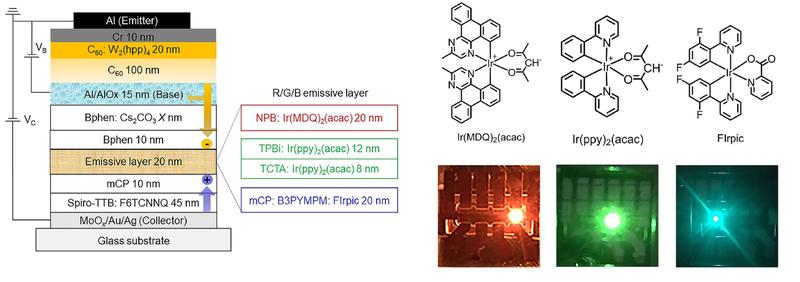

Aufbau eines vertikalen organischen permeablen Leucht-Basistransistors.
©Zhongbin Wu
In a new publication in the scientific journal “Nature Materials”, researchers of the Institute for Applied Physics at TU Dresden introduce a novel device concept towards high-efficient and low-voltage vertical organic lighting-emitting transistors. With the new device architecture and fabrication technology, the team paves the way for a broad application of efficient OLED active matrix displays.
In the group of Prof. Karl Leo, physicists, material scientists and engineers are working jointly on the development of novel organic materials and devices for high performance, flexible and possibly even biocompatible electronics and optoelectronics of the future. Increasing the performance of organic devices is one of the key challenges in their research. It was only last year, when the team headed by Dr. Hans Kleemann announced an important breakthrough with the development of efficient, printable vertical organic transistors.
Now Dr. Zhongbin Wu, Dr. Yuan Liu, and PhD student Erjuan Guo present the first electronic device that combines a vertical organic permeable base transistor (OPBT) and an OLED. With this novel device concept of an organic permeable base light-emitting transistor (OPB-LET), the researchers succeeded in combining the function of a highly efficient switching transistor and an organic light-emitting diode as commonly employed in active matrix displays. Active matrix liquid crystal displays (AMLCD) usually contain a matrix of thin-film transistors to drive LCD pixels. Each individual pixel has a circuit with active components (mostly transistors).
In this context, organic light-emitting transistors, three-terminal devices combining a thin-film transistor with a light-emitting diode, have generated increasing interest. However, increasing their efficiency while keeping the operating voltage low remains a key challenge. “The key to construct the high performance OPB-LETs is the permeable base electrode located at the center of the device, forming a distinctive optical microcavity and regulating charge carrier injection and transport. The thus designed three-terminal vertical optoelectronic devices can simultaneously high efficiencies (up to 24.6%), high luminance (up to 12,513 cd m-2), and low driving voltages (<5.0 V),” explains Erjuan Guo.
The performance of OPB-LETs demonstrated in this work is comparable to state-of-the-art OLEDs and cutting-edge, low-voltage organic transistors. Prof. Karl Leo explains: “We expect that this novel device principle will pave the way for highly-efficient flexible displays with a rather simple pixel design.”
Wissenschaftliche Ansprechpartner:
Erjuan Guo (English)
Email: erjuan.guo@tu-dresden.de
Prof. Karl Leo (Deutsch)
Chair of Optoelectronics
Email: karl.leo@tu-dresden.de
Originalpublikation:
Z. Wu, Y. Liu, E. Guo, G. Darbandy, S.-J. Wang, R. Hübner, A. Kloes, H. Kleemann, and K. Leo “Efficient and low-voltage vertical organic permeable base light-emitting transistors”, Nature Materials, DOI: https://dx.doi.org/10.1038/s41563-021-00937-0
Weitere Informationen:
https://tu-dresden.de/tu-dresden/newsportal/news/dresdner-physiker-entwickeln-dr…












